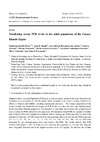Please use this identifier to cite or link to this item:
https://accedacris.ulpgc.es/jspui/handle/10553/73887
| Title: | Monitoring serum PCB levels in the adult population of the Canary Islands (Spain) | Authors: | Burillo-Putze, Guillermo Domínguez Boada, Luis María Alberto Henriquez-Hernandez, Luis Navarro, Patricio Zumbado, Manuel Almeida-Gonzalez, Maria Isabel Dominguez-Bencomo, Ana Camacho, Maria Luzardo, Octavio P. |
UNESCO Clasification: | 32 Ciencias médicas | Keywords: | Polychlorobiphenyls Pops Serum Samples Adult Subjects Biomonitoring, et al |
Issue Date: | 2015 | Journal: | Aims Environmental Science | Abstract: | Polychlorinated biphenyls (PCBs) are persistent organic chemicals that have been detected in human serum or tissues all over the world. These pollutants could exert a number of deleterious effects on humans and wildlife, including carcinogenic processes. The Spanish population of the Canary Islands was evaluated with respect to PCB levels more than ten years ago showing lower levels than other Western populations. The objective of our study was to assess the current level of contamination by PCBs showed by this population. We measured serum PCBs in a sample of healthy adult subjects (206 serum samples from subjects with an average age of 66 years old) to evaluate the potential modification of PCB serum levels in this population during the last decade. PCB congeners (28, 52, 77, 81, 101, 105, 114, 118, 123, 126, 138, 153, 156, 157, 167, 169, 180, and 189) were measured by gas chromatography-mass spectrometry (GC/MS). Our results showed that PCB residues were found in 84% of serum samples analyzed, the congeners 28, 153 and 180 being the most frequently detected and at the highest median values (0.1 ng/mL). In addition, the median concentration of the sum of those PCBs considered as markers of environmental contamination by these chemicals (Marker-PCBs) was 0.6 ng/mL, reaching values as high as as 2.6 ng/mL in the 95th percentile. Levels of the sum of PCBs with toxic effects similar to dioxins (dioxin-like PCBs) reached median values of 0.4 ng/mL in the 95th percentile. The reported levels are similar to those described previously in this population more than ten years ago, in the sense that the inhabitants of the Canary Archipelago show levels of PCB contamination lower than the majority of populations from developed countries. These findings suggest that currently there is not any active source of these chemicals in this archipelago. Nevertheless, as foods seem to be a relevant source for these compounds, Public Health authorities should monitor the presence of PCB residues in foods available in the market of these Islands. | URI: | https://accedacris.ulpgc.es/handle/10553/73887 | ISSN: | 2372-0344 | DOI: | 10.3934/environsci.2015.2.345 | Source: | Aims Environmental Science [ISSN 2372-0344], v. 2 (2), p. 345-352, (2015) |
| Appears in Collections: | Artículos |
Page view(s)
158
checked on Feb 1, 2025
Download(s)
113
checked on Feb 1, 2025
Google ScholarTM
Check
Altmetric
Share
Export metadata
Items in accedaCRIS are protected by copyright, with all rights reserved, unless otherwise indicated.
